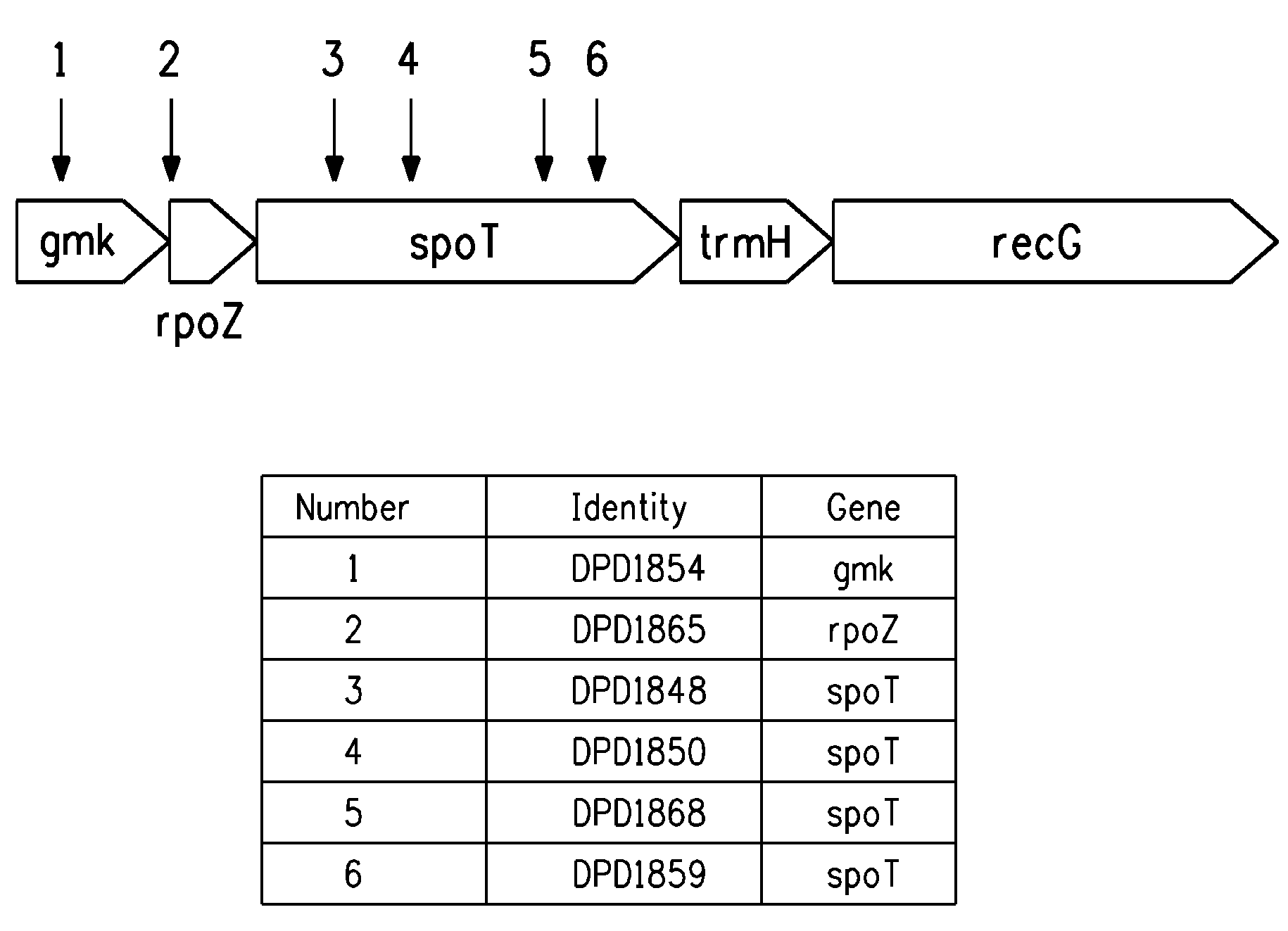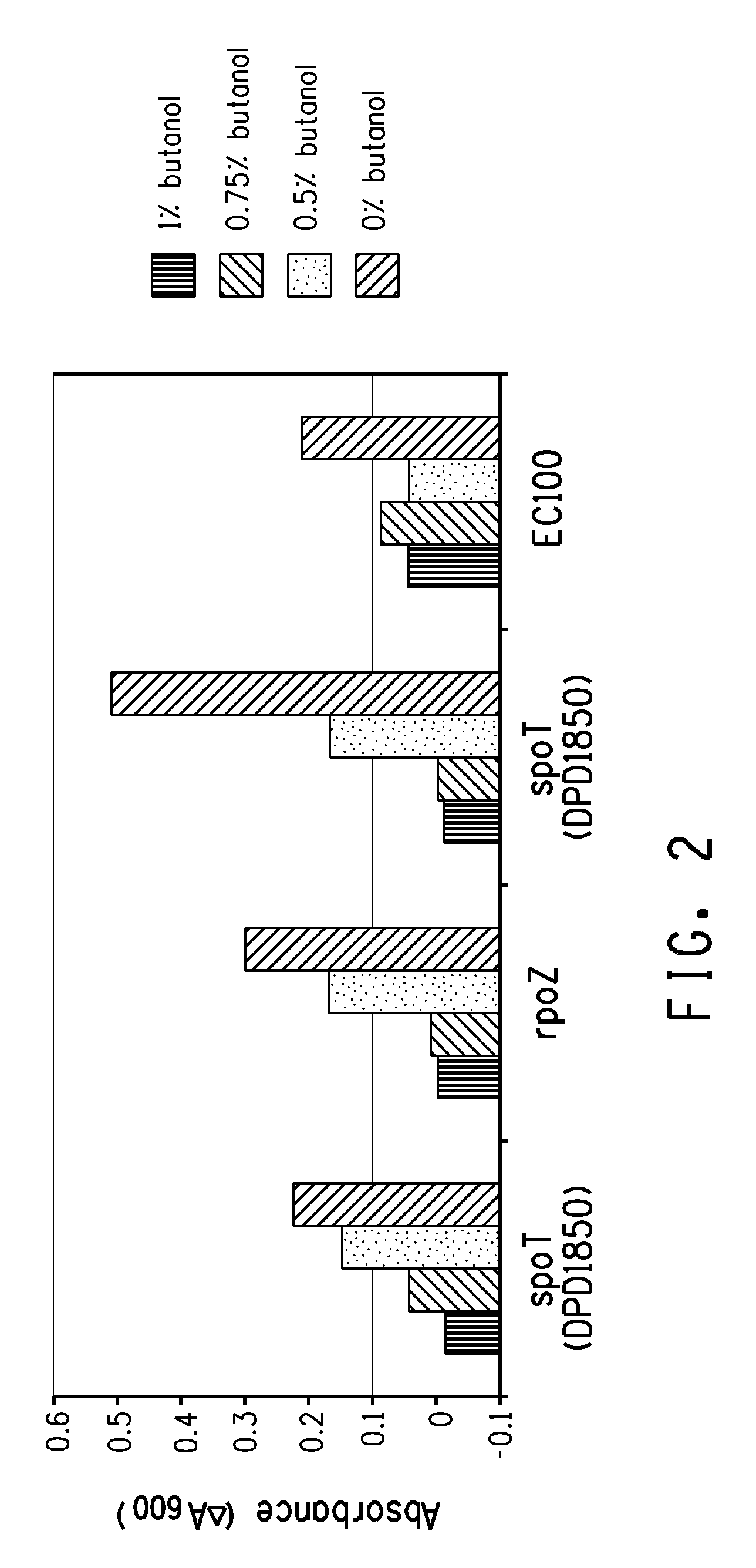Production of four carbon alcohols using improved strain
- Summary
- Abstract
- Description
- Claims
- Application Information
AI Technical Summary
Benefits of technology
Problems solved by technology
Method used
Image
Examples
example 1
Generation of Knockout Library and Screening to Identify 1-Butanol Phenotypes
[0188]E. coli strain EC100 (Epicentre; Madison, Wis.], whose genotype is F-mcrA Δ (mrr-hsdRMS-mcrBC) φ80dlacZM15 ΔlacX74 recA1 relA1 endA1 araD139 Δ (ara, leu)7697 galU galK λ-rpsL nupG, was transposome mutagenized. This was performed according to the vendor's (Epicentre; Madison, Wis.) protocol, using purchased electro-competent cells as the recipient in the genetic cross with the EZ-Tn5™Tnp Transposome™. 1 μl of the EZ-Tn5 Tnp Transposome was electroporated into EC100 cells. Immediately after electroporation, SOC medium was added to a final volume of 1 ml and the mixture was gently agitated before transfer to a tube that was incubated at 37° C. with shaking for 1 hr. The genetic cross yielded a titer ranging from 4 to 7×104 kanamycin-resistant colony-forming units per ml of electroporated cells.
[0189]100 μl aliquots of undiluted cells and dilutions were separately plated on LB medium containing 50 μg / ml ...
example 2
Mapping of Transposon Insertions in 1-Butanol Tolerant Strains
[0194]In order to link 1-butanol phenotypic alterations with a gene / protein / function, the transposon insertion positions were determined by sequencing. Genomic DNA was prepared from the identified 1-butanol tolerant lines using a GenomiPhi™ DNA Amplification kit (GE / Amersham Biosciences; Piscataway, N.J.) which utilizes Phi29 DNA polymerase and random hexamers to amplify the entire chromosome, following the manufacturer's protocol. A portion of a colony from a culture plate was diluted in 100 μl of water, and 1-2 μl of this sample was then added to the lysis reagent and heated for 3 minutes at 95° C. and cooled to 4° C. Next the polymerase was added and the amplification proceeded overnight at 30° C. The final step was enzyme inactivation for 10 minutes at 65° C. and cooling to 4° C.
[0195]The resulting genomic DNA was sequenced using the following primers that read outward from each end of the transposon:
SEQ ID NO:63 Kan2...
example 3
1-Butanol Tolerant Mutant Phenotypes in Liquid Cultures
[0199]Transposition mutant strains DPD1850 (spoT), DPD1848 (spoT), and DPD1865 (rpoZ) isolated in the above examples, and the EC100 control, were cultured overnight with shaking at 37° C. in LB before 1:100 dilution in fresh LB. After a 1 hr incubation, the culture was split into 1 ml aliquots (microfuge tubes) and 1-butanol was added to 0, 0.5%, 0.75% or 1% (w / v). After a further 2 hr incubation at 37° C. with shaking, 200 μl samples were transferred to a microtiter plate and optical density at A600 recorded. The microtiter plate was moved to a platform shaker that was located within a plastic box that is in a 37° C. incubator. Optical density was subsequently recorded at 4 hour and the results are shown in FIG. 2 as the difference between the 4 and 2 hr time points. In this experiment, the spoT and rpoZ lines showed improved growth in 0.5% 1-butanol.
[0200]Kinetic growth studies were performed for the DPD1848 and the control (E...
PUM
| Property | Measurement | Unit |
|---|---|---|
| Strain point | aaaaa | aaaaa |
Abstract
Description
Claims
Application Information
 Login to View More
Login to View More - R&D
- Intellectual Property
- Life Sciences
- Materials
- Tech Scout
- Unparalleled Data Quality
- Higher Quality Content
- 60% Fewer Hallucinations
Browse by: Latest US Patents, China's latest patents, Technical Efficacy Thesaurus, Application Domain, Technology Topic, Popular Technical Reports.
© 2025 PatSnap. All rights reserved.Legal|Privacy policy|Modern Slavery Act Transparency Statement|Sitemap|About US| Contact US: help@patsnap.com



